In this article, I describe 5 of the most popular SDRs available for RF experimentation today. As a 6th member of this list, I include a surprisingly common and free SDR that can be used for your fun radio projects.
Table of Contents
5. Universal Software Radio Peripheral (USRP)
4. LimeSDR
3. HackRF One
2. ADALM-Pluto
1. RTL-SDR
0. A Free SDR
We start with a little bit of background and where we came from.
Background
Software Defined Radio (SDR) has revolutionized wireless communication in the same way Microsoft revolutionized the scope of personal computing in its early days. Today the SDRs are used by electronics and DSP engineers, amateur radio hobbyists, physicists, cybersecurity professionals, financial service providers and countless others who come from a diverse set of civilian, military, industrial and academic backgrounds. Some of its major applications are in the following areas.
- Point-to-point wireless links
- 2G, 3G, 4G, 5G handsets and base stations
- Aircraft tracking
- Satellite imagery
- Drone and UAV control and networking
- Smart grid
- Radar
- Gateway for industrial Internet of Things (IoT)
- Experimentation
- Amateur radio
- Emergency responders and public safety communication
- Radio astronomy
Now to put things in perspective, we start with a brief overview of where we came from.
Where We Came From
In the old days, a conventional workflow in designing a radio went as shown in the figure below. The arriving signal was captured from the air and electronic circuits were used for modification and extraction of the desired signal. These were the days of analog modulation like Amplitude Modulation (AM) and Frequency Modulation (FM).

In the hindsight, all these circuits were carrying out mathematical operations. And what can carry out mathematical operations better than a computer? In particular, after the publication of Shannon’s landmark paper A mathematical theory of communication, the era of digital communication truly set in. This led to a change in radio design where analog signal processing was still dominant but demodulation was performed on a digital machine, as illustrated in the figure below. This demodulation was little more than making symbol decisions based on predefined decision regions.

The idea of Software Defined Radio (SDR) first appeared in 1970s but it became more popular after a publication by J. Mitola. It was not conceived out of thin air as the era of digital electronics was changing the landscape of audio, photography and almost every other technology at the same time. Thanks to Moore’s Law that predicted a doubling of transistor density every 18 to 24 months, the analog signal processing part of the digital receiver started shrinking, while the digital signal processing part started expanding. Many of the functions that were thought impossible to implement in digital domain could easily be carried out in digital machines, not only at a better cost but also with surprisingly ingenious techniques.
While the exact hardware vs software partitioning depends on the radio architecture, an illustrative block diagram is drawn in the figure below.

Since a digital signal processor, a microcontroller, or an FPGA, is programmed through software, we can say that the software portion in a receiver determines whether the radio is an SDR or not. An ideal software radio is the one in which there is exactly zero percentage of analog signal processing. The signal is directly sampled at the antenna and all subsequent functions are carried out in a digital machine. A direct sampling receiver architecture comes as close to realizing this goal as possible.
Top SDRs
Some of the most popular SDRs today are as follows.
5. Universal Software Radio Peripheral (USRP)
USRP was developed by Ettus Research and has been quite popular in the wireless community, particularly among the academic researchers. For them, connecting your device to a host computer using a high-speed link, enabling control of the hardware and data transmission/reception through host-based software was a dream come true. This enabled them to implement and verify the results of their innovative ideas, which could only be done in simulations before and real wireless transmission was considered an effort of industrial proportion. For independent standalone operations, a class of USRP models also features an embedded processor thus eliminating the need for a general-purpose processor.

Some of the salient features of USRP B210 as a reference are as follows.
- Frequency range: 70 MHz – 6 GHz (based on Analog Devices AD9361)
- ADC and DAC: 12 bits wide
- Channel bandwidth: Up to 61.44 MHz
- MIMO support: 2×2
- FPGA: Xilinx Spartan-6
In terms of cost, USRP B210 lies on the expensive side with a price range of US$ 2000+.
4. LimeSDR
Like other SDRs, LimeSDR is used by RF experts to build any of the applications mentioned before. In addition to these primary customers, it addresses a much wider audience through Snappy Ubuntu Core that is similar to an app store concept. The idea is to connect producers and consumers of the software where the users can easily download new apps developed by individuals around the globe and run them on the LimeSDR hardware.
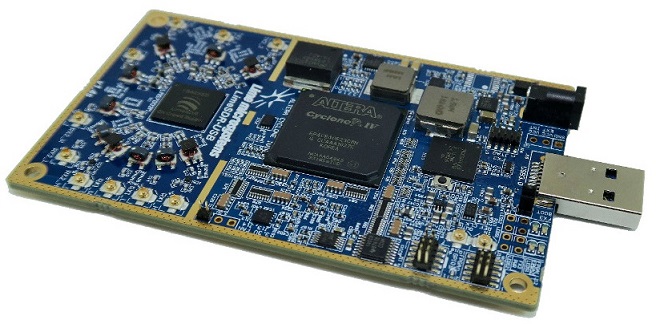
Some of its main features are as follows.
- Frequency range: 100 kHz – 3.8 GHz
- ADC and DAC: 12 bits wide
- Channel bandwidth: Up to 61.44 MHz
- MIMO support: 2×2
- FPGA: Altera Cyclone IV
In terms of cost, the LimeSDR lies in the upper middle part of the price range at US$ 700+.
3. HackRF One
The HackRF One was developed and produced by Michael Ossmann from Great Scott Gadgets. Its main appeal lies in its open-source nature, attracting the interest of not only amateur radio enthusiasts but also from hackers and RF security practitioners. It has been regularly used for demonstrations of RF hacking in cybersecurity conferences.
Some of its important features are as follows.
- Frequency range: 1 MHz – 6 GHz
- ADC and DAC: 8 bits wide
- Channel bandwidth: Up to 20 MHz
- MIMO support: None
- FPGA: None
In terms of cost, the HackRF lies in the middle of the price range at US$ 300+.
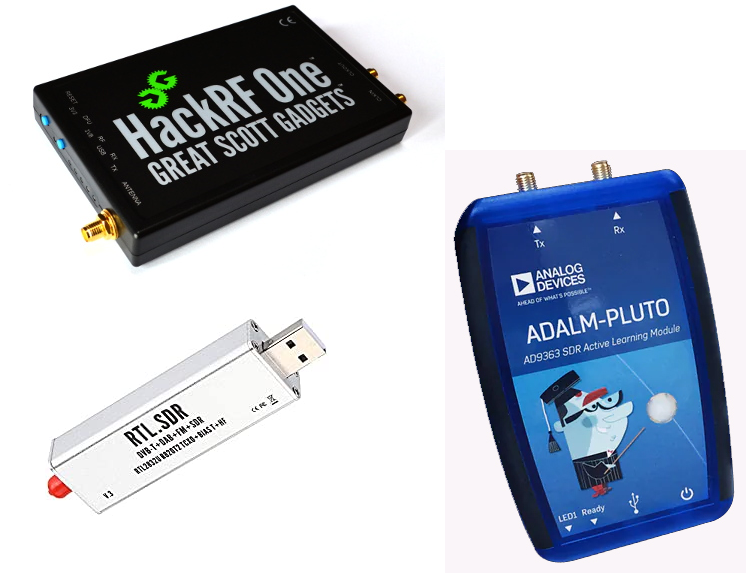
2. ADALM-Pluto
ADALM-Pluto is one of my favorite SDRs due to its ease of use and level of integration. The acronym ADALM stands for Analog Devices Active Learning Module, as the Analog Devices projects this device as a portable and self-contained RF lab that is specifically designed to cater to students, faculty and self-learners from all levels and backgrounds. Due to a variety of resources available online, ADALM-Pluto is my first recommendation if you are looking for the fastest route to building a project of your interest.
Some of its salient features are as follows.
- Frequency range: 325 MHz – 3.8 GHz (based on Analog Devices AD9363). Nevertheless, this frequency range can be extended to Tx/Rx up to 6 GHz with a little tweaking.
- ADC and DAC: 12 bits wide
- Channel bandwidth: Up to 20 MHz
- MIMO support: There is no MIMO in older versions. However, new Rev. D features include second Tx and Rx channels routed out to U.FL connectors in the PCB that enable a MIMO operation with some modifications. According to Analog Wiki, this second Tx/Rx is not tested during production and hence ADALM-Pluto is not an officially MIMO device.
- FPGA: Xilinx Zynq Z-7010
In terms of cost, the ADALM-Pluto lies towards the lower middle of the price range at US$ 250+.
1. RTL-SDR
RTL-SDR is the most popular option in this list. The inception of RTL-SDR can be traced back to the wide usage of mass-produced DVB-T TV tuner dongles, which relied on the RTL2832U chipset. It was discovered that the chip captures the raw I/Q samples and allows to transfer them to the host computer. This discovery along with its affordability led to RTL-SDR transform from a simple DVB-T tuner to the most widely used SDR in the world.
Some of its important features are as follows.
- Frequency range: 500 kHz – 1.766 GHz
- ADC and DAC: 8 bits wide
- Channel bandwidth: Up to 2.4 MHz
- MIMO support: None
- FPGA: None
In terms of cost, the RTL-SDR is the cheapest option at US$ 30+. Below is a summary of what we have discussed so far.
| USRP B210 | LimeSDR | HackRF One | ADALM Pluto | RTL-SDR | |
|---|---|---|---|---|---|
| RF Range | 70 MHz to 6 GHz | 100 kHz to 3.8 GHz | 1 MHz to 6 GHz | 325 MHz to 3.8/6 GHz | 500 kHz to 1.766 GHz |
| Bandwidth | 61.44 MHz | 61.44 MHz | 20 MHz | 20 MHz | 2.4 MHz |
| ADC | 12 bits | 12 bits | 8 bits | 12 bits | 8 bits |
| MIMO | 2×2 | 2×2 | None | None (officially) | None |
| FPGA | Xilinx Spartan-6 | Altera Cyclone IV | None | Xilinx Zynq Z-7010 | None |
| Duplex | Full | Full | Half | Full | Rx Only |
We now turn towards our final SDR.
0. Your PC’s Soundcard
The 5 SDRs described above are commonly known but what if you do not want to use any of them and still desire to send your signal over the air to demodulate it yourself? There is a lesser-known SDR that is free and easier to use for RF experimentation. And that is your PC’s soundcard that comes with an ADC and a DAC. In the audio band, the speakers act as wireless transmitters and the microphone acts as a wireless receiver, see the figure below.
This is how learners in my SDR course implement a final project on a single PC in which a file is sent and received over the air using its soundcard.
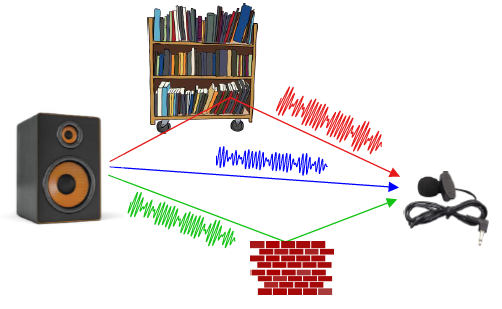
If you already own one of the above mentioned SDRs, it is still possible to complete the course project for over-the-air transmission. You will simply have to replace the Audio block in the GNU Radio Companion file with the corresponding block that interfaces with your SDR, and that’s it. Good luck for the fun experimentation.

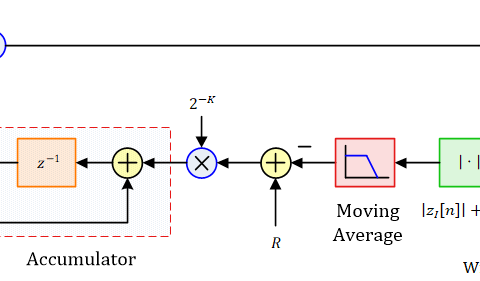
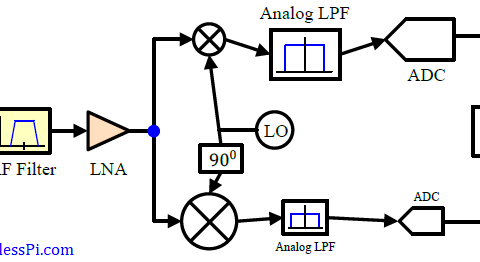
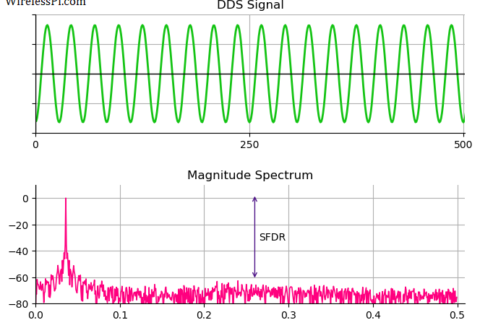
Why is DRM not open for discussion or experimenting anymore? It feels that FRAUNHOFER INSTITUTE dreamed of making alot of money with – and after a big boom. The possibility of research interests in DRM and the whole theme itself is exed and forgotten for a financial interest – forever.
Great insights on the top SDRs for RF experimentation! I’ve been considering getting into this field, and your detailed breakdown of features and capabilities really helps. Can’t wait to try out some of these recommended options!
Great insights on the top SDRs for RF experimentation! I appreciate the detailed comparisons and recommendations. It’s exciting to see how these technologies continue to evolve and open up new possibilities for hobbyists and researchers alike. Thanks for sharing!
Great breakdown of the top SDRs! I’ve been considering getting into RF experimentation, and this list really helps narrow down my options. The pros and cons you mentioned, especially about usability and price, are super helpful. Thanks for sharing!
Great post! I found the comparison of the different SDRs really helpful, especially the insights on their capabilities for RF experimentation. Can’t wait to try out some of the options mentioned!